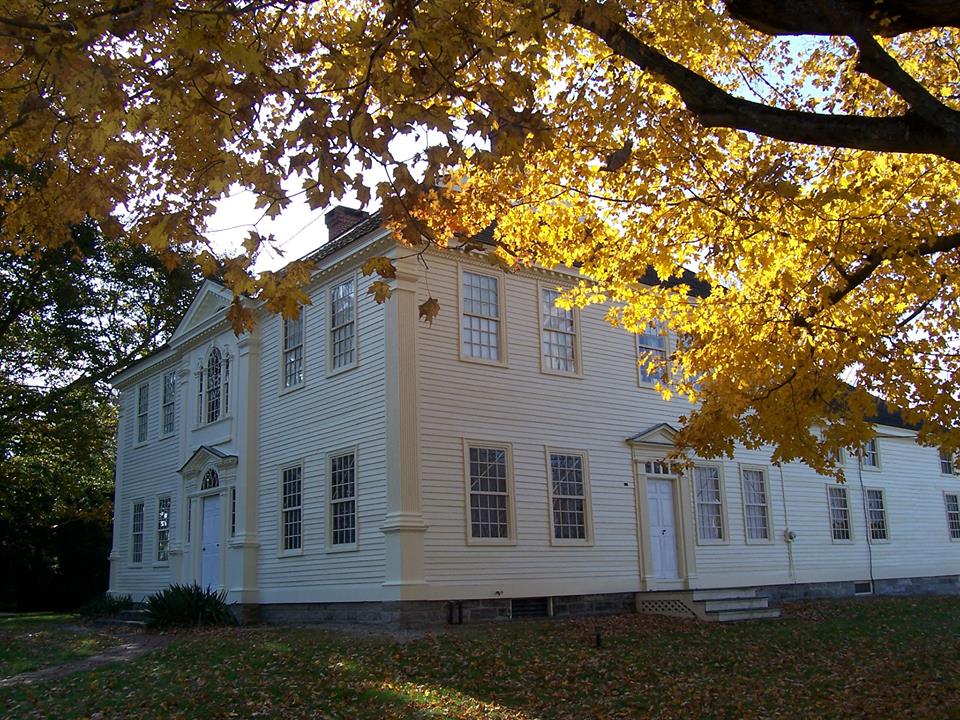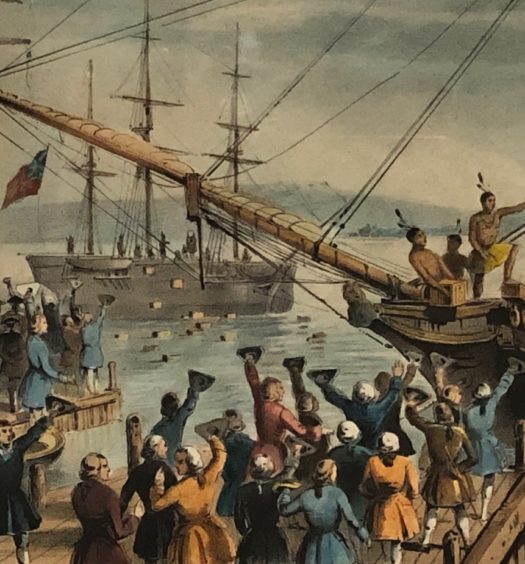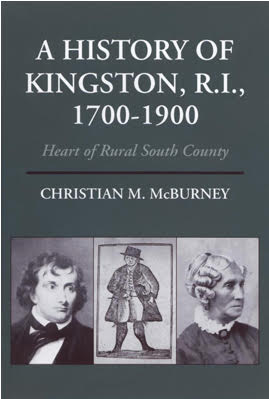In the first half of the nineteenth century, while most white New Englanders opposed slavery in the South, they nonetheless did not believe that their freed Black neighbors should be extended the same legal rights as whites or be treated as the social equals of whites. The idea that Black persons should be accorded equal rights did not begin to take hold in the North until after the Civil War.
States in New England (and the rest of the North) typically restricted free adult Blacks from one or more of the following activities: voting in elections for government office; holding elective office; serving on a jury; riding in train cars with whites; and having their children attend integrated schools.
Nowhere in New England did this sad state of affairs come to light more clearly than in Canterbury, Connecticut, in 1833 and 1834. There, a white teacher, Prudence Crandall, opened a school for young Black women, New England’s first. Within a year and a half, after a campaign of violent attacks and harassment, as well as lawsuits, the residents of Canterbury had forced the school to close because they objected to the Black students receiving an education in their town.
The three extraordinary female protagonists of this story named in the article’s title had important Rhode Island connections. Prudence Crandall was born and educated in Rhode Island. Her first Black student, Sarah Harris, would marry a blacksmith from Kingston, Rhode Island, and she would eventually make her permanent residence in Kingston. Another Black student, Ann Hammond, who was threatened with a public whipping, hailed from Providence.
On September 3, 1803, Prudence Crandall was born in the two-story home of her maternal grandfather, Hezekiah Carpenter, in the village of Carpenter’s Mills, Rhode Island, near Hopkinton. Her parents, Pardon and Esther, shortly after Prudence’s birth moved down the road, into another home owned by Hezekiah Carpenter, on nearby Mechanic Street. Pardon, irritated by living near his successful father-in-law, in 1813 purchased a farm in Canterbury, Connecticut, and moved his family there.
Prudence had a Quaker upbringing. Unlike most whites of the time, Quakers believed that all persons, regardless of race, deserved equal rights and equal treatment.
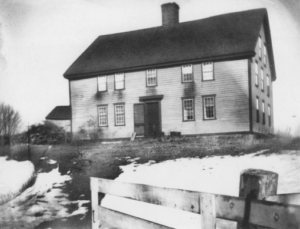
The Hezekiah Carpenter House in Hopkinton, Rhode Island, where Prudence Crandall was born in 1803 (Langworthy Public Library, Hope Valley)
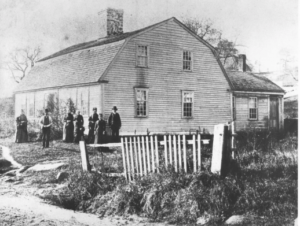
The Pardon Crandall House in Hopkinton, where Prudence Crandall and her family moved into shortly after her birth (Langworthy Public Library, Hope Valley)
From ages 22 to 25, Prudence received a superb education at the New England Yearly Meeting School, or the Friend’s School as it was known, in Providence. Its founder was the then elderly Quaker abolitionist, Moses Brown. The school was progressive in educating both male and female students. One of Prudence’s fellow students was Elizabeth Buffum, the future Rhode Island abolitionist and women’s rights advocate. (In 1904 the school was renamed the Moses Brown School and is still operating today.)
Crandall became a schoolteacher. In the fall of 1831, she opened a school for young women in a white-clapboard schoolhouse on the village green in Canterbury, in eastern Connecticut. With the support of the town, more than twenty young white women enrolled and paid tuition. Crandall quickly made the Canterbury Female Seminary a success.
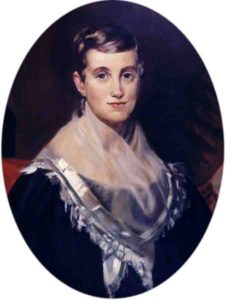
Close-up of Prudence Crandall, painted by Francis Alexander in Boston in 1834 (Prudence Crandall Museum)
At the end of the first year, in September 1832, a meeting occurred that would alter the course of Crandall’s life. A twenty-year-old local Black woman, Sarah Harris, approached Crandall and asked if she could enroll as a full-time student at her school. Harris added that her father, a successful local farmer, could afford the tuition. Harris told Crandall of her desire “to get a little more learning, if possible, enough to teach colored children.” Both Harris and Crandall knew that while Connecticut’s laws did not mandate segregated schools, social custom assumed separate private schools for the two races. Harris added, “If you think it will be the means of injuring you, I will not insist on the favor.”
Sarah Harris was born in 1812, one of twelve children. Her father, William Harris, was a literate black man who in his spare time sold copies of The Liberator, the abolitionist newspaper edited by William Lloyd Garrison of Boston. The newspaper espoused the then radical notion that slavery in the South should be immediately abolished (and not gradually over time) and that Blacks merited equal treatment. Sarah Harris read the newspaper too. Her sister, Maria, worked as a household servant in Crandall’s school, occasionally sat in on classes, and reportedly brought copies of The Liberator to Crandall.
Crandall did not provide an answer immediately. But after thinking over the momentous matter, she agreed to the request. As a Christian, she refused, she said, to treat Sarah “with unkindness and contempt, merely to gratify the prejudices of the rest.” Crandall also concluded, “Education was to be one of the chief instruments by which the condition of our colored population is to be improved.”
The young white female students accepted Sarah as their new classmate. But their parents had a different reaction—many of them threatened to withdraw their daughters if Crandall allowed Harris to continue as a student. If the complaining white parents followed through on their threats, Crandall knew that her school could not survive financially.
Crandall boldly decided not to give in to the demands to dismiss Harris. Instead, she secretly decided to dismiss all of her white students and teach only young Black women. In making her decision, Crandall consulted with William Lloyd Garrison at Boston and also received support from Providence abolitionist Arnold Buffum, the father of Prudence’s former classmate, Elizabeth Buffum.
Crandall, with introductions from Garrison, began visiting Black families in New England cities and New York City who might be interested in sending their daughters to Crandall’s school in Canterbury. Her first trip was to the Hammond family in Providence. Thomas Hammond had owned and operated a successful boarding house in Providence. After he died unexpectedly in 1826, his wife, Elizabeth, took over operating the boarding house. Crandall visited Elizabeth, who introduced Crandall to Elizabeth’s daughters, Ann Eliza and Sarah Lloyd. The next day Elizabeth took Crandall to meet three other Black families, who must have been dissatisfied with the segregated educational opportunities in Providence. The meetings went well, with Crandall informing Garrison, “They seemed to feel much for the education of their children, and I think I shall be able to obtain six scholars from Providence.” Crandall had some success in other cities as well.
On February 25, 1833, Crandall gathered her 24 white female students and informed them that she was temporarily closing her school at the end of the term and would reopen in the next term as a school for Black young women only. The announcement surprised the students and sent shockwaves throughout the community.
Crandall’s school for “young ladies of color,” held in the Canterbury Female Boarding School building, opened in April 1833. It immediately spurred white opposition in the town, county, and state.
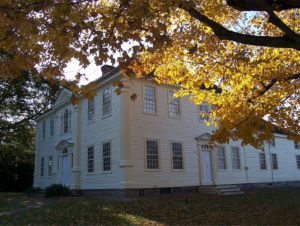
The Canterbury Female Boarding Academy, Connecticut, used by Prudence Crandall as her school for Sarah Harris and other young women of color, is now the Prudence Crandall Museum (Prudence Crandall Museum)
The leader of the opposition to Crandall’s school was Andrew T. Judson, a leading Canterbury citizen, the town’s top attorney, and an avowed racist. He believed that Crandall’s school would help spur a civil war between the North and the South. His position was that both free and enslaved Blacks should establish colonies for themselves in Africa. He was a good example of how many supporters of the colonization of Blacks in Africa, at this time, were avowed racists. Crandall’s worst offence, Judson said, was her intention to “have the African race placed on the same footing of perfect equality with [white] Americans.” Judson told one of Crandall’s supporters, “The colored people can never rise from their menial condition in our country . . . . They are an inferior race of beings, and never can or ought to be recognized as the equals of whites. Africa is the place for them.”
On April 12, 1833, sixteen-year-old Ann Eliza Hammond of Providence became the first out-of-state Black student to enroll in Crandall’s school in Canterbury. She boarded at the schoolhouse, along with Sarah Harris. Ann would later be joined at the school by her younger sister, Sarah Lloyd, Elizabeth N. Smith of Providence, and Mariah Robinson of Providence. Two other students likely hailed from Rhode Island: Amy Fenner (based on her last name, well known in Rhode Island), and Mary Elizabeth Miles (known to have been born in Rhode Island in 1819 to Quaker parents).
Opponents of the school saw their chance to apply Connecticut’s vagrancy statute against Ann Hammond. It authorized Windham County officials to assess a fine against a non-resident if the non-resident was a risk of becoming a financial burden on the town. The cruel law was intended to apply to jobless and homeless vagrants who entered the state. If the fine was not paid, the county had an assortment of penalties it could impose, including whipping the non-resident “on the naked body not exceeding ten stripes.” Hammond came from a middle-class family and was no vagrant. Nonetheless, the county sheriff served a writ on Hammond warning her that that the vagrancy law would be applied against her and that if she did not pay the fine her “naked body” would be lashed with a whip.
According to the Reverend Samuel May, a Congregationalist minister from a nearby Connecticut town who stepped up to assist Crandall and her school, Hammond was “animated by the spirit of a martyr.” But rather than risk the awful prospect of a public whipping of a naked Hammond, Crandall paid the fine from her own funds.
Judson successfully sought a solution at the state level. In May, the Connecticut legislature passed a law that authorized Connecticut towns to ban, fine, and prosecute any person who assisted in teaching any “colored persons who are not inhabitants of this state.” The fines for violating what became known as the “Black Law” were heavy—$100 for the first offense, $200 for the second offense, and doubling thereafter. This was at a time when a typical mill worker or tradesmen earned about $1.10 a day.
When news of the law’s passage reached Canterbury, its residents rushed out of their homes in celebration, gathered at Judson’s home, and fired a cannon near the town’s center for thirty minutes. One student later recalled, “Where is the justice? In the midst of all this, Miss Crandall is unmoved. When we walk out [of the school], horns are blown and pistols fired.”
Crandall agreed to challenge Judson and the rest of the town and risk arrest, fines, and jail by violating the Black Law. She was duly arrested and thrown in debtor’s prison overnight. Reverend May was not displeased. He said that the people of Connecticut would not “realize how bad, how wicked, how cruel” the Black Law is “unless we suffer her persecutors to inflict upon [Crandall] all the penalties it prescribes . . . . It is easy to foresee that Miss Crandall will be glorified, as much as her persecutors and our State will be disgraced, by the transactions of this day and this hour.”
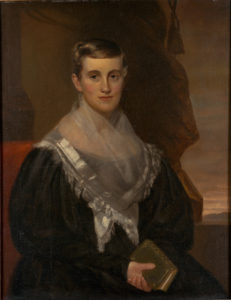
Full portrait of Prudence Crandall, painted by Francis Alexander in Boston in 1834 (Cornell University Library)
At trial, the prosecution proved that Crandall had been teaching in Canterbury young Black women, such as Ann Hammond, from other states. Crandall’s attorneys then challenged the Black Law on the ground that it violated the “privileges and immunities” clause of the U.S. Constitution. That clause provided that “the citizens of each state shall be entitled to all privileges and immunities of citizens in the several states.” It was meant to protect citizens of one state who traveled to another state from discrimination. If Blacks were citizens of a state, then the Black Law on its face violated the clause.
Judson, unsurprisingly, argued that Blacks were not citizens. He had some support in the U.S. Constitution itself, which mentioned slavery (but not Black persons) three times: in Article I, Section 2, relating to representation in the House by counting three-fifths of every enslaved person in the census; in Article I, Section 9; the 20-year moratorium on any federal law banning American participation in the foreign slave trade; and in Article IV, Section 2, which provided that runaway enslaved persons did not become free by entering a state that prohibited slavery. Judson’s main argument was that Connecticut permitted only “free white males” to vote in elections so that only whites could be citizens. He also warned the jury that if the South emancipated its slaves, they could “send them all to Connecticut instead of Liberia.”
The attorney representing Crandall, Williams Ellsworth, argued in response, “Is it so that a person born on our soil is not a citizen of our land? In the days of the Revolution, these men fought side by side with our fathers, and shed blood for this country, which was their country—the country to which they owed indefeasible allegiance.” Ellsworth noted that Black veterans of the Revolutionary War for their service in the Revolutionary War received pensions and land grants. He then read the opening lines of the Declaration of Independence (even though the Declaration was not a formal U.S. law): “We hold these truths to be self-evident, that all men are created equal, that they are endowed by their creator with certain inalienable rights, that among these are life, liberty and the pursuit of happiness.” Ellsworth pointed out that the phrase did not add “except black men” after every clause.
The jury was unable to reach a verdict. Credit for the inability of the jury to convict Crandall was extended in part to a newly published newspaper edited by Charles Burleigh and funded by the New York City abolitionist Arthur Tappan, called The Union, which staunchly defended Crandall’s school.
Judson was not done with Crandall. On September 26, 1833, a new writ was served on the school principal, charging her with the same violation of the Black Law. At the second trial, with Judson doggedly attacking Crandall, the jury returned with a verdict of guilty. The presiding judge, David Daggett, had advised the jury that Blacks did not enjoy the same rights as whites because they were not citizens.
Crandall appealed the verdict to the Connecticut Supreme Court. Four justices of Connecticut’s highest court, including its Chief Justice, David Daggett, heard the appeal. Remarkably, even though he had served as the trial judge, Daggett did not recuse himself from the appeal.
Crandall’s defense again centered on the position that the Black Law violated the privileges and immunities clause of the U.S. Constitution. Anticipating Andrew Judson’s arguments that Blacks were not citizens because Black men could not vote in Connecticut, Crandall’s defense attorney made the same arguments made at trial as to why Blacks should be treated as citizens under the U.S. Constitution. The attorney added that Black men were, in fact, permitted to vote in four of the six New England states (not Rhode Island or Connecticut), as well as in eight other states. Counsel further made the sensible argument that white women and minors could not vote, but that they were surely considered citizens.
The Connecticut Supreme Court issued a decision overturning the verdict against Crandall, on a three-to-one vote, with only Judge Daggett dissenting. However, the ruling was based on a mere technicality, which was questionable at best. The justices ruled that the prosecution had not alleged that Crandall had failed to obtain a license from town officials from her school., as the Black Law purportedly required. Under this ruling, the Black Law remained on the books as enforceable law.
Donald E. Williams, an author of an excellent recent biography of Prudence Crandall, argues that documents he reviewed indicated that the three justices in the majority were prepared to reverse the verdict on the grounds that Blacks were citizens and that the Black Law was a violation of the privileges and immunities clause of the U.S. Constitution, but that they had rejected this course out of a desire not to embarrass their colleague, Judge Daggett. Another prescient commentator wrote, “The court could not brave the storm of unpopularity by deciding in her [Crandall’s] favor and could not go on record as declaring an unconstitutional law as constitutional.”
Basing the ruling of a technicality was a bitter blow to abolitionists, because if the ruling had been rendered on the broader alternative ground, the U.S. Supreme Court would have had to decide the issue, and at that time may well have concluded that Blacks were citizens. Instead, in 1856, U.S. Supreme Court Chief Justice Roger B. Taney, in the infamous Dred Scott case, wrote the majority opinion ruling that Blacks were not citizens.
The Connecticut Supreme Court’s ruling placed the parties back where they had been before the trial. This state of affairs was not satisfactory to the whites of Canterbury, who became frustrated that the lengthy legal proceedings had not yet closed Crandall’s school.
The Windham County Advertiser had published a piece declaring that “A determination has been formed to BREAK UP the negro school in Canterbury by some means or other in less than two months.” One month later, in January 1834, a mysterious fire broke out in Crandall’s schoolhouse. The building was damaged, but injuries to boarders and others were avoided. On another occasion, someone slit the throat of a cat and hung it by the neck on a gate at the entrance to the school. It was not uncommon at night for eggs, rocks or mud to be thrown at the school.
The campaign of harassment took a more violent turn. At midnight on September 9, 1834, a gang of white men silently surrounded the school armed with armed iron bars and large wooden clubs. Suddenly, at the assigned signal, they swung their weapons to smash the five main first-floor windows of the school. Fortunately, the flying shards of glass from the more than ninety broken windowpanes did not injure any of the sleeping students or staff. The attackers disappeared into the night—none were ever charged with their crime. Crying students were led outside to safety, away from the shards of glass on the wooden floors.
This violent attack was the last straw for Crandall. Fearing for the safety of her students and staff, she decided to close her school permanently. Twenty young Black women, eager to learn, had lost their chance to receive a superior education. Over its short one-and-a-half year existence, Crandall’s school had educated thirty students of color. The Reverend Samuel May bitterly observed, “I felt ashamed of Canterbury, ashamed of Connecticut, ashamed of my country, ashamed of my color.”
Unfortunately, the racism shown by Canterbury whites was not limited to their town or state. Throughout New England at this time, whites were not ready to mix with Blacks or to treat them as deserving of equal rights. For example, in Canaan, New Hampshire, by October 1834, Noyes Academy was teaching young white and Black men, as well as women. In August of 1835, over a two-day period, angry white men of the town pulled the schoolhouse down. The Black students quickly left Canaan.
Prudence Crandall never regained her footing. Her brother, Reuben, was arrested in August 1835 in Washington, D.C. on a charge of distributing antislavery literature and left to rot for eight months in a dank prison by the city’s attorney general, Francis Scott Key, the author of “The Star Spangled Banner.” At trial, Reuben was found not guilty by a jury and freed, but in 1838 he died of tuberculosis, which he had contracted while imprisoned. He sacrificed his life for the antislavery cause.
Prudence married an unstable man, Calvin Philleo, who had been a fiery preacher at a congregation in Pawtucket. The couple had children and later moved to Illinois. Prudence established a small new school and taught there for a few years, but she spent much of her time on isolated farms. Calvin Philleo died in 1874. Prudence moved to a farm on the prairie outside the small town of Elk Falls, Kansas, where she lived in a plain box house with only a few rooms and wore clothing she sewed herself.
By 1885, after the Civil War, and when race relations had improved somewhat in Connecticut, the story of Prudence Crandall’s efforts to teach young Black women attracted new interest. Out of a sense of guilt, in 1885, a campaign began in Connecticut to grant Crandall a pension. The writer Mark Twain even offered to purchase her old house in Canterbury and allow her to live in it. The Connecticut legislature, after some delays, finally passed a law providing Crandall with a lifetime pension, which allowed her to purchase a small house in Elk Falls. Meanwhile, Rhode Island’s General Assembly and the town of Hopkinton (Prudence’s birthplace) each appropriated $150 for a Connecticut memorial to the former school principal.
Sarah Harris’s life took a more positive turn. On November 28, 1833, Sarah married George Fayerweather, a blacksmith from Kingston, Rhode Island, whose father and grandfather had been blacksmiths there. The grandfather started the business after he became free from enslavement. George’s grandmother, Nancy Rodman, was descended from Ninigret, chief of the Niantic branch of Narragansetts.
After the wedding, Sarah withdrew from Crandall’s school and she and her new husband moved to New London, where George carried on the trade of a blacksmith. The newlyweds’ first child, born on September 9, 1834, the same day the Canterbury schoolhouse was attacked by a mob, was named, fittingly, Prudence Crandall Fayerweather.
In 1855, the Fayerweathers moved to George’s home village of Kingston. George, Sarah, and their five children moved into the eastern half of the rambling old Helme House (then across from the current Kingston Hill Store and years later destroyed by a fire). Sarah Harris Fayerweather had purchased this real estate in 1853. George’s widowed mother continued to live a few houses down the road in a Cape Cod cottage that George was raised in, which still stands. George joined his brother Solomon in running the local blacksmith shop.
Sarah Harris Fayerweather continued to support the abolitionist movement. Sarah reportedly hosted many antislavery lecturers at her home in Kingston, and circulated antislavery tracts and newspapers to local families. Reportedly, the couple became conductors on the Underground Railroad, helping fugitive slaves on their journeys north to freedom in Canada (but there is no hard evidence of it).
Sarah corresponded with William Lloyd Garrison and his wife, Helen, the daughter of an abolitionist from Providence, George Benson. Sarah subscribed to, and avidly read, The Liberator. Sarah’s intimacy with Garrison, a tower of strength in the abolitionist movement, and his wife, Helen, was reflected by Sarah’s annual Christmas holiday custom of sending the Garrison family a long-lasting fruitcake.
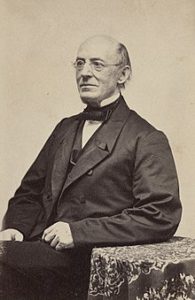
William Lloyd Garrison, the great abolitionist and editor of The Liberator, strongly supported Prudence Crandall from 1833 to 1835 and remained a lifelong friend of Sarah Harris Fayerweather. Photograph is circa 1870 (Wikipedia)
Sarah traveled to attend antislavery meetings. A letter written in 1863 from Helen Garrison states that her husband enjoyed seeing Sarah in New York and accompanying her to an antislavery lecture by Wendell Phillips, another leader of the antislavery movement. The daughter of Calvin Philleo, from Philleo’s first marriage, described in a letter meeting Sarah for the first time, which occurred in Boston at a meeting of the Massachusetts Anti-Slavery Society in 1863. The daughter wrote that she met “a colored woman of very pleasing manners and appearance,” and was intrigued to learn that she was the Sarah Harris of her “Mother Crandall’s” school. She continued:
I invited her to come and pass the afternoon with me, which she did yesterday, and I wish you could have been here to hear her talk of the days of Mother’s persecution, and also to her many things about Mother, for whom she entertains the warmest love and gratitude . . . . I do not know when I have enjoyed an afternoon better than in this woman’s society. She is very intelligent and lady-like, well informed in every movement relative to the removal of slavery and converses very well . . . .
With Union victory in the Civil War and emancipation in the Southern states drawing nearer, the abolitionists who had worked so hard all those previous bleak years basked in glory. After the fall of Charleston in February 1865, the Lincoln administration decided to make the recaptured Fort Sumter the place for a dramatic pageant to commemorate the symbolic end of the war. At President Lincoln’s suggestion, William Lloyd Garrison was invited as a dignitary. Sarah Harris Fayerweather was thrilled for Garrison, writing to him:
I praise the name of the Lord that he has prolonged your precious life to see this day. My joy is full when I think of your being at Charleston, South Carolina, having those very slaves for whom you have tolled a persecuted lifetime bowing down at your garment . . . I can say that it is glory enough for our century.
Garrison’s daughter was married in early 1866. Sara sent the Garrison family a huge wedding cake by express from Providence.
After the war, Sarah Harris Fayerweather resumed her correspondence with Prudence Crandall. Sarah informed Prudence of the death of her husband George in 1869. Crandall wrote back to Sarah, “You do not know how much I thank you for your kind remembrance, and how much my cup of joy would run over if I could see [you] face to face if it was but one hour.” Prudence informed Sarah in 1871 that Ann Hammond had traveled to England. Prudence added, “I have no friend on earth I would be more rejoiced to see than yourself.” They promised to see each other again and share their antislavery and family experiences.
Sarah kept her promise to visit Prudence, after celebrating her 66th birthday on April 16, 1878. Despite occasional poor health, she took the long trip by steam train from Kingston Station to Independence, Kansas, changing rail lines numerous times. Sarah then gathered her luggage and boarded a stagecoach for the thirty-mile trip to Elk Falls. She had one last leg to complete, hiring a wagon to bring her about a mile to Prudence’s farm.
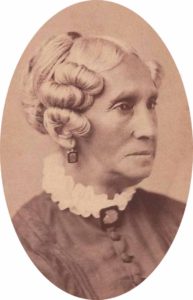
Photograph of Sarah Harris Fayerweather, probably taken when she was in her early 60s, which would have been around 1874 (Prudence Crandall Museum)
Prudence’s nine-year old niece answered the door. She later recalled of Sarah Harris Fayerweather, “She was quite a fine looking woman with regular features, and with white hair with deep waves.” She added, “There was much animated talk between them.” The two remarkable, now elderly women, enjoyed their reunion, sharing stories about their incredible common past at Canterbury, as well as friends and supporters they had in common. Prudence was pleased to learn that two of Sarah’s children, Sarah and George, had become teachers.
After a two-week stay, Sarah began the long journey back to Kingston. When she returned, she experienced a health problem that had afflicted her earlier in her life—an acute swelling of the neck. This time, the condition worsened and Sarah lost the ability to speak. Sarah Harris Fayerweather passed away on November 16, 1878, at the age of 66. She was buried next to her husband in the Fayerweather plot in Old Fernwood Cemetery on the outskirts of Kingston. Upon her death, William Lloyd Garrison, who would die the following year, sent Sarah’s children a poem in remembrance. Prudence wrote to one of Sarah’s daughters, Mary Fayerweather, telling her how sorry she was to hear of her mother’s passing and sending her love to all of her mother’s children. Prudence herself died on January 28, 1890, at the age of 86.
In 1970, the University of Rhode Island named a newly constructed residence hall in honor of Sarah Harris Fayerweather. The University of Rhode Island library possesses a collection of Sarah’s papers in the Fayerweather family papers. In 1965, the Fayerweather house was acquired and restored by the Kingston Improvement Association. The Fayerweather Craft Guild operates a craft gift shop in the building.
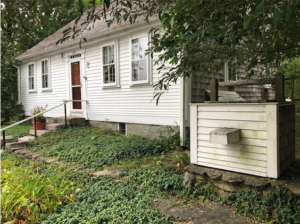
The George Fayerweather house, built circa 1820 in Kingston, one of the few houses of a middle class Black family that remains in Rhode Island. This house was built by the father of Sarah Harris Fayerweather’s husband, both named George. It is now occupied by the Fayerweather Craft Guild gift shop. The Solomon Fayerweather house (1852) is next door to the east. Sarah Harris Fayerweather resided to the west in the Helme House, which no longer exists. It was located in the field across the street from the Kingston Hill Bookstore. (Christian McBurney)
The Canterbury Female Boarding School building is now the Prudence Crandall Museum. Located at 1 South Canterbury Road, it is currently undergoing renovations and may reopen in 2021.
[Banner image: The former school building in Canterbury, Connecticut, used by Prudence Crandall as her school for young women of color, now the Prudence Crandall Museum (Prudence Crandall Museum)]
Bibliography
Most of the information on Prudence Crandall and her failed efforts to operate a school at Canterbury, Connecticut, is derived from an excellent book by Donald E. Williams, Jr., Prudence Crandall’s Legacy, The Fight for Equality in the 1830s, Dred Scott, and Brown v. Board of Education (Middletown, CT: Wesleyan Press, 2014). This book was also the source of much information on Sarah Harris Fayerweather and Ann Eliza Hammond.
Most of the information on Rhode Island students is from a list of students and their backgrounds provided by the Prudence Crandall Museum. It can be accessed at:https://portal.ct.gov/-/media/DECD/Historic-Preservation/04_State_Museums/Prudence-Crandall-Museum/Black-Students-1833-1834.pdf?la=en. Thank you also to Joan DiMartino of the museum for answering some of my questions and providing some of the images for this article.
Lorraine Arruda, president of the Hopkinton Historical Association, provided information on Prudence Crandall’s time in Hopkinton.
Information on Sarah Harris Fayerweather and the Fayerweather family is also derived from Christian M. McBurney, A History of Kingston, R.I., 1700-1900, Heart of Rural South County (Kingston, RI: Pettaquamscutt Historical Society, 2004) and the Fayerweather Family Papers in the Special Collections of University of Rhode Island Library.
Unfortunately, around 2004, four of the original five letters written to Sarah Harris Fayerweather by Prudence Crandall and Helen Garrison were stolen, probably by a researcher, from the Special Collections at the University of Rhode Island Library. These historical treasures had been safely stored in the archives building next to the Kingston Free Library and Reading Room since about the 1950s. In the late 1990s, these letters were transferred to the college library. At least copies of the letters still exist.
Information on Reuben Crandall and his trial and death is from Jefferson Morley, Snow Story in August, Washington City, Francis Scott Key, and the Forgotten Race Riot of 1835 (New York, NY: Doubleday, 2012).

